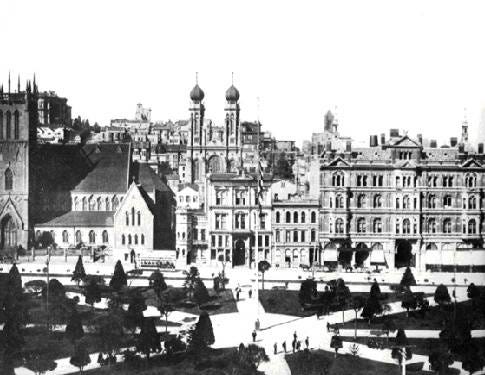Daily Diary, April 17, 2023 Day 958:
Having decided that San Francisco parks would play a role in my upcoming short story, Dandy and the Dognappers, I have been reviewing both the history of urban parks in general, as well as the specific history of parks in San Francisco. A nice little research rabbit hole to duck down that I thought might be of interest to some of you.
First of all, in the nineteenth century, as American cities grew at an astounding rate, there was a movement to make sure that some green spaces survived. In smaller towns, the countryside was close by, and many people still used local cemeteries as a place to stroll on a Sunday afternoon, or even picnic. However, by the late 19th century, in order to free up valuable real estate, even these cemeteries were being moved to the outskirts of cities, and there was a movement to reserve the few open spaces that still existed as public parks.1
San Francisco was no exception. By 1850, there were only three small areas in the center of the city slated for green space, Portsmouth Square, Union Square, and Washington Square, and then with the beginning of the suburbs to the west, seven additional squares were laid out, including Jefferson Square where my characters from the boarding house go to celebrate July Fourth picnics. However, the most ambitious park was Golden Gate Park, which city leaders wanted to rival New York City’s Central Park. To that end, in 1870 the state legislature set the boundaries and set up a governor appointed Board of Park Commissioners. William Hammond Hall was then hired to design the park, a project that would take years to complete.2
I had my two protagonists, Annie and Nate, take a carriage ride through Golden Gate Park in the first book of the series, Maids of Misfortune, when the park was still under development, and they also went and had a picnic there in Uneasy Spirits. Here is a blog post by me on the subject.3
Following the pattern of other cities, in San Francisco cemeteries became an alternative to public parks for those who wanted some green spaces. Some of the cemeteries were located south of Market, others further west near Lone Mountain. These cemeteries continued to play the role of preserving green spaces where people could not just visit the graves of loved ones, but also stroll on paths, under trees, and sit on benches and enjoy the view. The expansion of horse and cable car lines that went directly to the cemeteries on Lone Mountain sped up this process. In time, however even these cemeteries were deemed as taking up too much valuable real estate, and they would be slowly moved again.4
As a side note, in the suburb of Pittsburgh where I grew up in the 1950s, most of the borough had been farm land prior to WWII. Eventually, in the 1960s they built a municipal park—jungle gym, ball fields, swimming pool--but prior to that time, I met my friends at the small cemetery up the road. The church it had been attached to was gone, but the small area of green remained, and I had a quick kiss from my first crush there one evening, smile.
For the short story, however, I am not going to use cemeteries or the more famous Golden Gate Park as a setting, but instead will use one or more of the smaller public squares. Jefferson Square is conveniently familiar to my young protagonists, and near-by. However, I would like to pick some squares that are located near the large hotels, of the city, many of which, like the Palace Hotel had suites were people lived permanently. San Francisco had a reputation as a place where the cost of land and housing, and servants, was so high that many people of the upper classes found it more convenient to live in fancy hotels. (I think this is a topic for another post, so I won’t expand on this here.)
In any event, in addition to Jefferson Square, the most logical additional small park in terms of being located in walking distance from some of these hotels was Union Square.
Union Square was bounded by Geary on the south and Post to the north, between Powell to the west, and Stockton to the east. This put it only 2 blocks to the west of the Palace Hotel on Market Street, and by 1882, the square was fenced in, and had grass, pathways, trees and plants, and benches for sitting.5
It was also in easy walking distance from four well-known hotels. The Palace Hotel and the Baldwin Hotel were only two blocks away from Union Square, and Lick House and Occidental Hotel that were five blocks away. Interestingly, Union Square was also only 4 blocks away from Annie’s O’Farrell Street boardinghouse.
I don’t know whether or not people staying at those hotels, or their servants, took their dogs to Union Square, or let the dogs off leash to play on the grass. But I can very well imagine that they would have, so I will write my short story accordingly!





Thank you for all of this great information. Sure wish you had been my Jr. High History teacher, Mary Lou!!!
I’am a History Buff so these tidbits on Parks fell right in my line of interest.